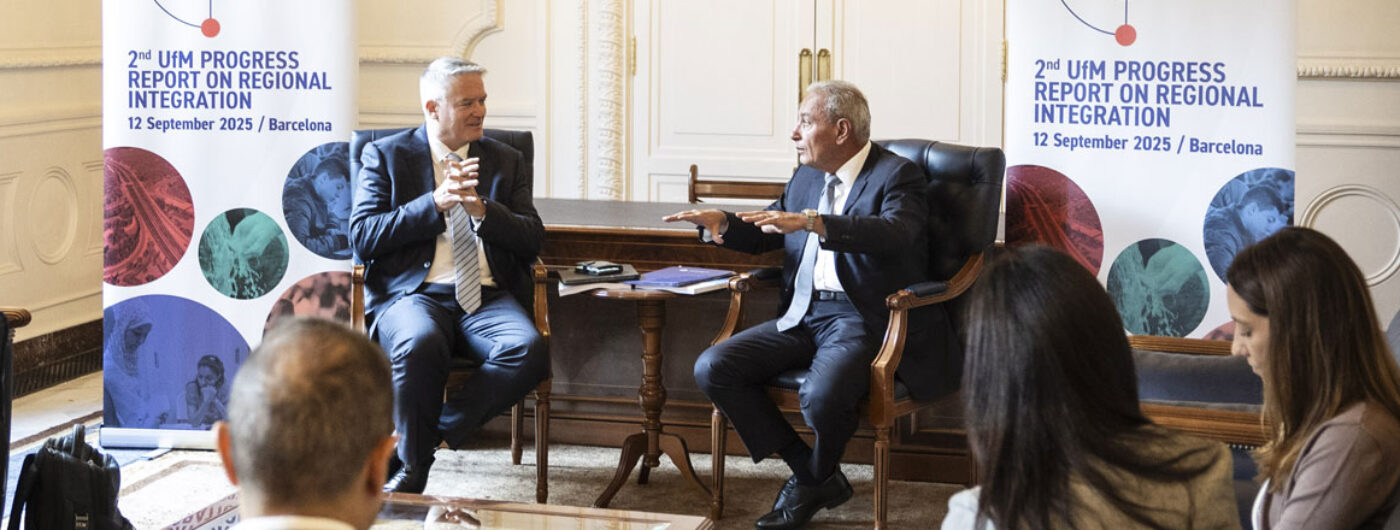
Economic integration in Euro-Mediterranean region lagging despite potential for sustainable growth and development, UfM report finds
- The 2nd UfM Progress Report on Regional Integration, published in collaboration with the OECD and supported by the German Development Cooperation, was presented today in Barcelona. The data-driven report provides insights on the state of Euro-Mediterranean economic interconnectedness as well as actionable policy recommendations.
- Although trade flows among UfM Member States accounted for 30% of all global exports in 2022, the Euro-Mediterranean market is still highly fragmented. While foreign direct investment has remained broadly resilient, in many countries it is surpassed by remittances. The region now hosts close to 80% more intra-UfM migrants than in 1990, the majority of which originate from EU countries.
- Regional integration remains below potential due to persistent challenges to the movement of goods, services, capital, people and technologies. The green transition, however, offers new opportunities, as do enhanced infrastructure connectivity and evolving models for the mobility of people.
12 September 2025, Barcelona. The 2nd UfM report on the state of economic integration in the Euro-Mediterranean region, developed in partnership with the OECD with the support of the German Development Cooperation (GIZ), was presented today at Barcelona’s Palau Reial palace. Coinciding with the 30th anniversary of the Barcelona Process, it builds on the previous edition and provides key findings and policy recommendations in five domains: trade, finance, infrastructure, movement of people, and higher education and research. The launching ceremony of the report also brought together representatives of different regional integration processes and stakeholders to showcase best practices that can be adapted and replicated in the Euro-Mediterranean region.
The report highlights the complex geopolitical context in which Euro-Mediterranean economic integration processes occur, pointing to the severe repercussions caused by the ongoing conflicts in Ukraine and the Middle East, disrupting supply chains, energy security and prices as well as efforts to foster investment attractiveness and socioeconomic growth and resilience. At the same time, it takes stock of the positive trend of increasing ties between UfM Member States and the Gulf region, now an important source of foreign direct investment especially in MENA countries, as well as Pan-African initiatives.
Infrastructure connectivity is described as central to boosting not only regional trade and investment, but also R&I collaboration and economic diversification in countries that need it the most. Strengthening transport networks by integrating road, rail and maritime links can optimise routes and promote sustainability in a region responsible for 13.4% of global transport emissions, a 40% increase since 1990. Likewise, cross-Mediterranean renewable energy exchanges, which offer significant potential given the MENA region’s capacity to support the EU’s ambitious climate goals, will depend on expanding infrastructure and its integration into local and regional energy grids.
With intra-UfM migration growing by 6% between 2021 and 2024, the report also notes the growing recognition of the need for improved management of migration patterns. Skills and talent partnership programmes, for example, show promise in this regard as they combine the needs of receiving and sending countries, preventing brain-drain while also alleviating labour market needs. The region now hosts over 34 million intra-UfM migrants, the biggest share of which come from the EU, although those from MENA countries and the Western Balkans are on the rise.
“Regional integration has long been central to the UfM’s mission, and this report acknowledges both the progress achieved and the challenges that remain,” said UfM Secretary General Nasser Kamel. “Global and regional crises continue to reshape our economies, opening our eyes to the importance of moving towards more modernised and sustainable economic models. We must seize this moment to build inclusive economies where young people and women can thrive, guided by a shared commitment to regional integration as a driver of development.”
Additional resources


